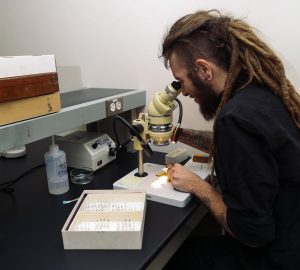You have heard of mites – minute arachnids that have four pairs of legs when adult, are related to the ticks and live in the soil, though some are parasitic on plants or animals. But what are vermiform mites? Maybe you have heard of vermi-compost, a composting technique that uses worms (like your earthworm in the garden) to decompose organic matter. So vermiform mites are mites with a body shape like a worm:
Why are they shaped like a worm, you may ask – To find out more I interviewed Samuel Bolton, former PhD student in the acarology collection at our museum, now Curator of Mites at the Florida State Collection of Arthropods. Sam’s main research interest is in mites that live on plants and in the soil, especially Endeostigmata, a very ancient group of mites that dates back around 400 million years, before there were any trees or forests. Sam’s PhD research with Dr. Hans Klompen here at OSU, was focused on a small family (only five described species) of worm-like mites, called Nematalycidae.
side note: You may have heard of Sam’s research in 2014 when he discovered a new species of mite, not in a far-away country, but across the road from his work place in the museum.
When Sam started his research it was not clear where these worm-like mites in the family Nematalycidae belong in the tree of life. To find out Sam studied several morphological characters of Nematalycidae and other mites. He focused in particular on the mouth-parts of this group. As he learned more about the mouth-parts of this family, he found evidence that they are closely related to another lineage of worm-like mites, the gall mites (Eriophyoidea). Eriophyoidea have a sheath that wraps up a large bundle of stylets. They use these stylets to pierce plant cells, inject saliva into them and suck cell sap.
Although Nematalycidae don’t have stylets, one genus has a very rudimentary type of sheath that extends around part of the pincer-like structures that have been modified into stylets in Eriophyoidea.
So what did Sam and his co-authors discover?
“.. Not only are gall mites the closest related group to Nematalycidae, but the results of our phylogenetic analysis places them within Nematalycidae. This suggests that gall mites are an unusual group of nematalycids that have adapted to feeding and living on plants. Gall mites use their worm-like body in a completely different way from Nematalycidae, which live in deep soil. But both lineages appear to use their worm-like bodies to move around in confined spaces: gall mites can live in the confined spaces in galls, under the epidermis (skin), and in between densely packed trichomes on the surface of leaves; Nematalycidae live in the tight spaces between the densely packed mineral particles deep in the soil.”
This research potentially increases the size of Sam’s family of expertise, Nematalycidae, from 5 species to 5,000 species. We have yet to confirm this discovery, but it is highly likely that gall mites are closely related to Nematalycidae, even if they are not descended from Nematalycidae. This is interesting because it shows that the worm-like body form evolved less frequently than we thought. This discovery also provides an interesting clue about how gall mites may have originated to become parasites. They may have started out in deep soil as highly elongated mites. When they began feeding on plants, they may have used their worm-shaped bodies to live underneath the epidermis of plants. As they diversified, many of them became shorter and more compact in body shape.
I wish I could tell you now to go out and look for these oddly shaped mites yourself, but you really need a microscope. Eriophyoid mites are minute, averaging 100 to 500 μm in length. For your reference, an average human hair has a diameter of 100 microns.
Reference:
Bolton, S. J., Chetverikov, P. E., & Klompen, H. (2017). Morphological support for a clade comprising two vermiform mite lineages: Eriophyoidea (Acariformes) and Nematalycidae (Acariformes). Systematic and Applied Acarology, 22(8), 1096-1131.

 About the Authors: Angelika Nelson, curator of the Borror Laboratory of Bioacoustics, interviewed Samuel Bolton, former PhD graduate student in the OSU Acarology lab, now Curator of Mites at the Florida State Collection of Arthropods, in the Florida Department of Agriculture and Consumer Services’ Division of Plant Industry.
About the Authors: Angelika Nelson, curator of the Borror Laboratory of Bioacoustics, interviewed Samuel Bolton, former PhD graduate student in the OSU Acarology lab, now Curator of Mites at the Florida State Collection of Arthropods, in the Florida Department of Agriculture and Consumer Services’ Division of Plant Industry.









